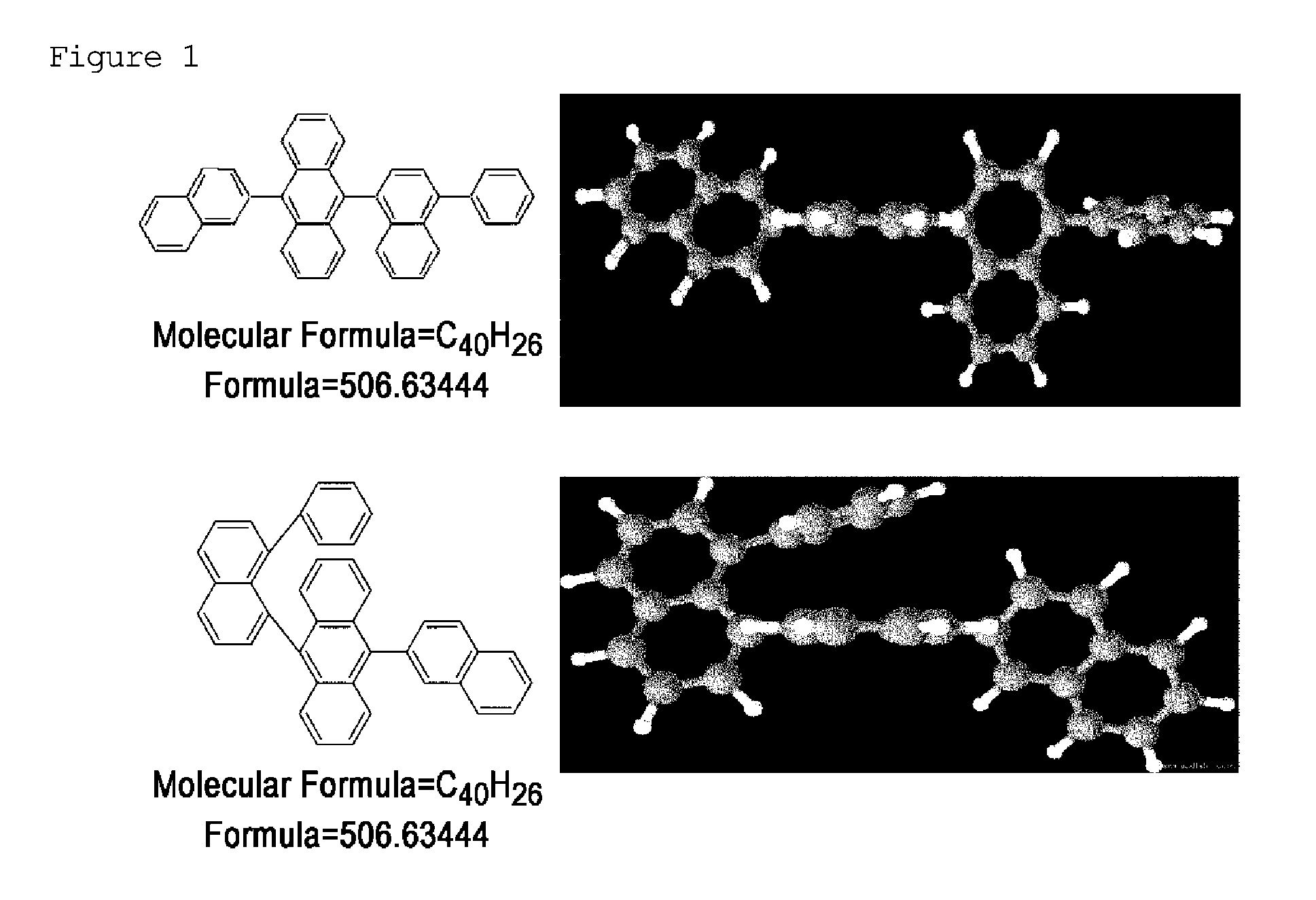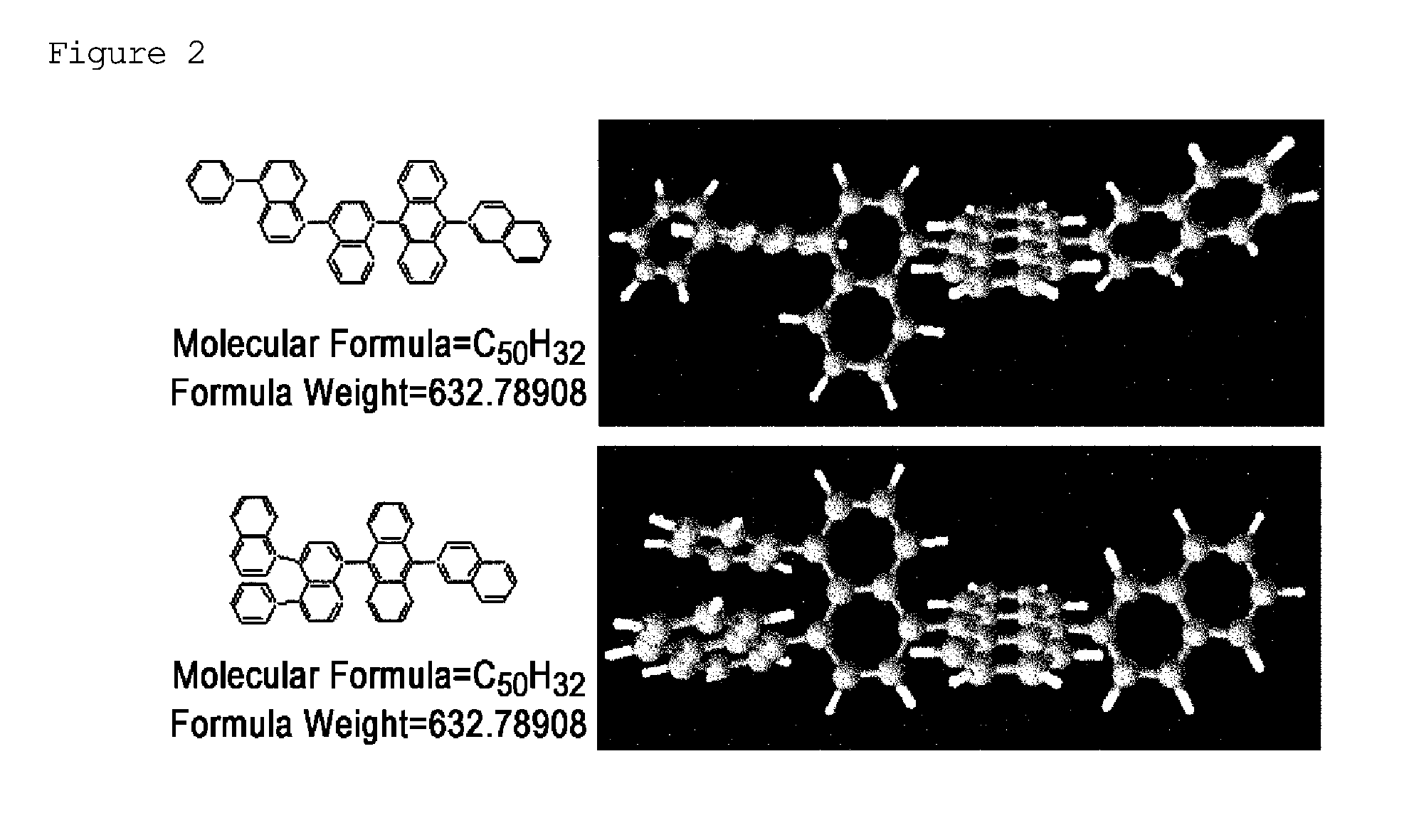Naphthalene derivative, organic material including the same, and organic electroluminescent device including the same
a technology of organic materials and derivatives, applied in the field of display, can solve the problems that compounds cannot be prevented from crystallizing, and achieve the effects of low driving voltage, excellent color purity, and high luminous efficiency
- Summary
- Abstract
- Description
- Claims
- Application Information
AI Technical Summary
Benefits of technology
Problems solved by technology
Method used
Image
Examples
example 1
[0079]A compound of Example 1 was prepared according to the following preparation method.
[0080]
Step 1: Preparation of Intermediate 1-1
[0081]2,6-dibromonaphthalene (50 g, 170 mmol), phenylboronic acid (23 g, 190 mmol) and tetrakis(triphenylphosphine)palladium(0) (6.1 g, 10 mmol) were dissolved in 500 mL of tetrahydrofuran, and 260 mL of a 2N aqueous solution of potassium carbonate was added thereto. Then, the mixture was allowed to react under reflux for 24 hours. After completion of the reaction, the reaction solution was extracted with ethyl acetate, and the organic layer was dried using anhydrous magnesium sulfate, and then purified through a hexane column, thereby obtaining intermediate 1-1 at a yield of 75% (37 g).
Step 2: Preparation of Intermediate 1-2
[0082]Intermediate 1-1 (50 g, 180 mmol) was dissolved in 1000 mL of tetrahydrofuran under an argon atmosphere, and 1.6 M n-butyl lithium (121 mL) was added thereto at −78° C., followed by stirring for about 1 hour. At the same tem...
example 2
[0085]The following compound was prepared in the same manner as described in Example 1, except that 1,6′-binaphthyl-2′-ylboronic acid was used instead of intermediate 1-2.
[0086]
[0087]1H NMR (200 MHz, CDCl3): d 7.28-7.32 (t, 2H), 7.43-7.46 (t, 2H), 7.57-7.71 (m, 18H), 7.88-7.93 (m, 4H), 8.40-8.46 (m, 4H), 8.50-8.56 (m, 2H)
example 3
[0088]A compound of Example 3 was prepared according to the following method.
[0089]
Step 1: Preparation of Intermediate 3-1
[0090]1,8-dibromonaphthalene (50 g, 170 mmol), phenylboronic acid (23 g, 190 mmol) and tetrakis(triphenylphosphine)palladium(0) (6.1 g, 10 mmol) were dissolved in 500 mL of tetrahydrofuran, and 260 mL of a 2N aqueous solution of potassium carbonate was added thereto. Then, the mixture was allowed to react under reflux for 24 hours. After completion of the reaction, the reaction solution was extracted with ethyl acetate, and the organic layer was dried using anhydrous magnesium sulfate, and then purified through a hexane column, thereby obtaining intermediate 3-1 at a yield 63% (31 g).
Step 2: Preparation of Intermediate 3-2
[0091]9-bromoanthracene (50 g, 190 mmol), phenylboronic acid (31 g, 250 mmol) and tetrakis(triphenylphosphine)palladium(0) (6.7 g, 10 mmol) were dissolved in 1000 mL of tetrahydrofuran, and 291 mL of a 2N aqueous solution of potassium carbonate ...
PUM
| Property | Measurement | Unit |
|---|---|---|
| work function | aaaaa | aaaaa |
| thickness | aaaaa | aaaaa |
| thickness | aaaaa | aaaaa |
Abstract
Description
Claims
Application Information
 Login to View More
Login to View More - R&D
- Intellectual Property
- Life Sciences
- Materials
- Tech Scout
- Unparalleled Data Quality
- Higher Quality Content
- 60% Fewer Hallucinations
Browse by: Latest US Patents, China's latest patents, Technical Efficacy Thesaurus, Application Domain, Technology Topic, Popular Technical Reports.
© 2025 PatSnap. All rights reserved.Legal|Privacy policy|Modern Slavery Act Transparency Statement|Sitemap|About US| Contact US: help@patsnap.com



